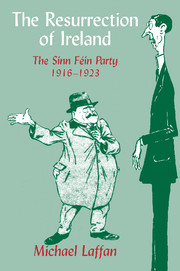Book contents
- Frontmatter
- Contents
- List of illustrations
- List of figures and tables
- Preface
- Note on the text
- List of abbreviations
- PROLOGUE: BEFORE THE EASTER RISING
- THE IRISH REVOLUTION, 1916–1923
- 2 Rebellion and hibernation, 1916
- 3 Organizers and converts, 1917
- 4 Reverses and victory, 1918
- 5 The party: structures and members
- 6 Policy: beliefs and attitudes
- 7 War and repression, 1919–1921
- 8 Ministers and bureaucrats, 1919–1921
- 9 The treaty and the split, 1921–1922
- 10 The Pact election and the Civil War, 1922–1923
- EPILOGUE: AFTER THE CIVIL WAR
- Select bibliography
- Index
5 - The party: structures and members
Published online by Cambridge University Press: 05 March 2012
- Frontmatter
- Contents
- List of illustrations
- List of figures and tables
- Preface
- Note on the text
- List of abbreviations
- PROLOGUE: BEFORE THE EASTER RISING
- THE IRISH REVOLUTION, 1916–1923
- 2 Rebellion and hibernation, 1916
- 3 Organizers and converts, 1917
- 4 Reverses and victory, 1918
- 5 The party: structures and members
- 6 Policy: beliefs and attitudes
- 7 War and repression, 1919–1921
- 8 Ministers and bureaucrats, 1919–1921
- 9 The treaty and the split, 1921–1922
- 10 The Pact election and the Civil War, 1922–1923
- EPILOGUE: AFTER THE CIVIL WAR
- Select bibliography
- Index
Summary
By the end of 1918 Sinn Féin had achieved most of its important objectives – except, of course, the achievement of an independent Irish republic. It had converted and organized nationalist opinion, defeated the Parliamentary Party, and secured the election of a large Sinn Féin majority among Irish MPs. These representatives could now proceed to establish a parliament and government in Dublin. The new scheme of organization approved by the October 1917 convention had been in operation for a year. The party had expanded to the natural limit of its membership, it had reached its peak, and it would soon decline.
Between 1919 and 1921 British censorship and suppression, followed by the hazards and horrors of war, would limit Sinn Féin's effectiveness and undermine its organization. The activities of the Volunteers would relegate it to a subordinate position, and the party would even be displaced as the main civilian expression of Irish separatism. Its moment of triumph in December 1918 is an appropriate point at which to examine Sinn Féin under various headings: how it was organized; the extent to which its aims and structures responded to Irish realities; who its members were; what they did; and how party membership affected their lives.
Theory
In some respects Sinn Féin's constitution and its scheme of organization were abstract constructs, irrelevant to the party's real life and inappropriate to the circumstances of the time.
- Type
- Chapter
- Information
- The Resurrection of IrelandThe Sinn Féin Party, 1916–1923, pp. 169 - 213Publisher: Cambridge University PressPrint publication year: 1999



